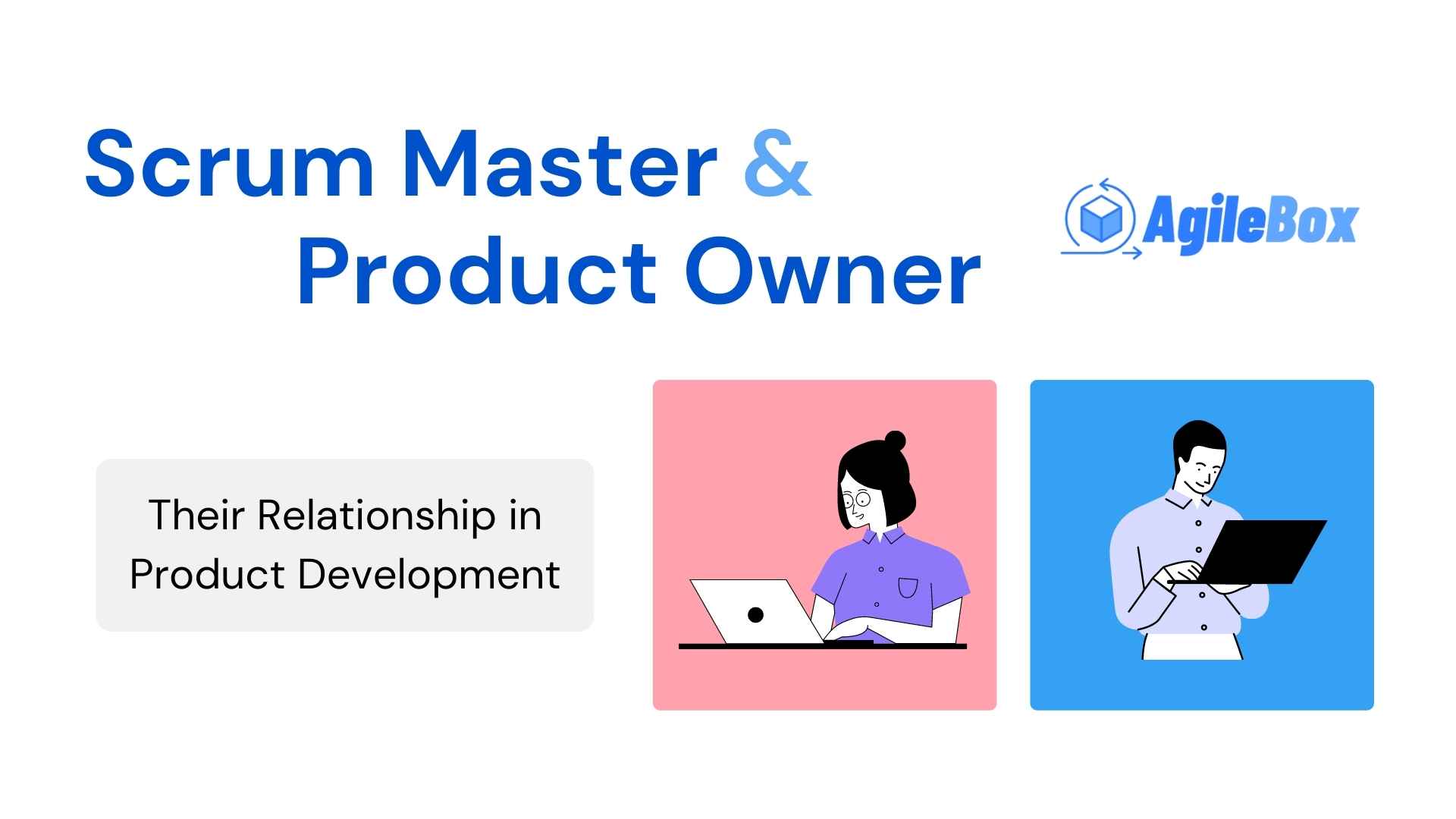Explore the collaboration between the Scrum Master and the Product Owner. Discuss how they work together to prioritize the product backlog, ensure clear communication, and deliver value to stakeholders.
Contents
- I. Introduction
- II. Responsibilities of the Scrum Master
- III. Responsibilities of the Product Owner
- IV. Key aspects of the Scrum Master-Product Owner relationship
- V. Challenges in the Scrum Master-Product Owner relationship
- VI. Strategies for building a strong Scrum Master-Product Owner relationship
- VII. Benefits of a strong Scrum Master-Product Owner relationship
- VIII. Conclusion
I. Introduction
Definition of Scrum Master and Product Owner roles
Scrum Master
A Scrum Master is a servant-leader who facilitates the Scrum process and helps the team collaborate effectively. The Scrum Master does not manage the team but coaches, mentors and removes impediments for them. The Scrum Master also works with the Product Owner and other stakeholders to ensure the product backlog is clear, prioritized, and aligned with the vision and goals.
Product Owner
A Product Owner is a visionary who represents the customer and stakeholders in the Scrum team. The Product Owner is responsible for defining and communicating the product vision, creating and managing the product backlog, and maximizing the product’s value. The Product Owner also collaborates with the Scrum Master and the team to plan and review the sprints and to provide feedback and acceptance for the deliverables.
Importance of the Scrum Master-Product Owner relationship
The Scrum Master and the Product Owner are critical roles in any Scrum team. They have different responsibilities but share a common goal: to deliver value to the customer and the business.
A strong Scrum Master-Product Owner relationship establishes a solid foundation for effective project management. It enhances team collaboration, promotes efficient communication, supports decision-making processes, resolves conflicts, and drives continuous improvement. Through their close partnership, the Scrum Master and Product Owner significantly contribute to the overall success of the project and the satisfaction of stakeholders and customers.
II. Responsibilities of the Scrum Master
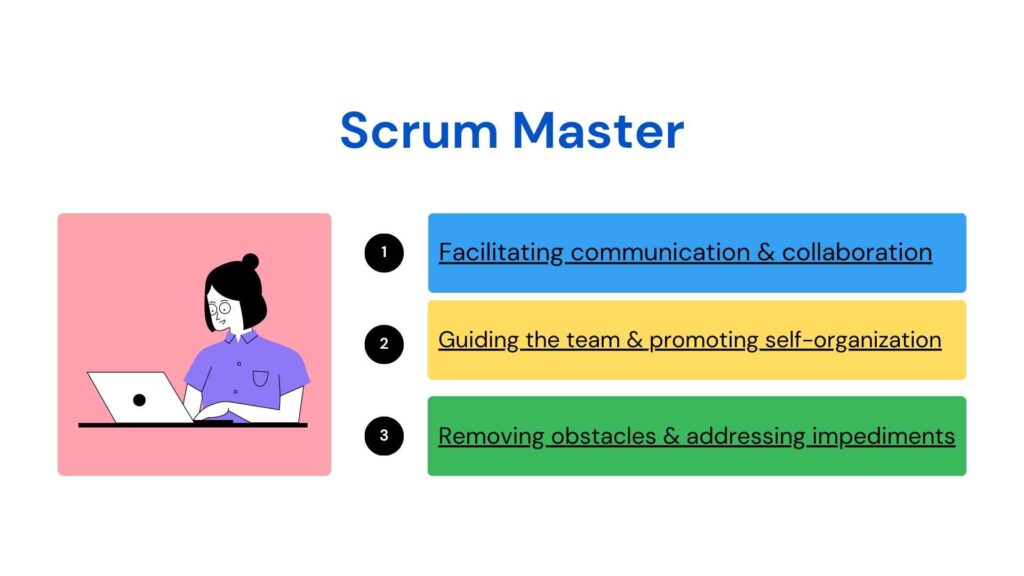
Facilitating communication and collaboration
The Scrum Master serves as a facilitator for effective communication and collaboration within the Scrum team. They create an environment that encourages open dialogue and information sharing among team members, stakeholders, and the Product Owner. The Scrum Master ensures everyone has the necessary information to perform their roles effectively.
They organize and facilitate various Scrum ceremonies, such as daily stand-up meetings, sprint planning, sprint review, and retrospectives. These meetings allow the team to discuss progress, challenges, and next steps. The Scrum Master actively listens to team members, encourages active participation, and resolves any communication barriers hindering collaboration.
Guiding the team and promoting self-organization
One of the primary responsibilities of the Scrum Master is to guide the development team and promote self-organization. They help the team understand and embrace the Scrum framework, its principles, and its values. The Scrum Master supports the team in becoming self-managing, empowering them to make decisions and take ownership of their work.
The Scrum Master encourages the team to follow Scrum practices like timeboxing, iterative development, and regular feedback cycles. They foster an environment where individuals are motivated and empowered to contribute their best, fostering creativity and innovation. By facilitating self-organization, the Scrum Master enables the team to maximize their potential and deliver high-quality products.
Removing obstacles and addressing impediments
A crucial responsibility of the Scrum Master is to identify and remove obstacles that impede the Scrum team’s progress. They proactively identify any issues, roadblocks, or dependencies that may hinder the team’s ability to deliver the product increment. The Scrum Master collaborates with stakeholders, such as management or external teams, to address these obstacles promptly.
Additionally, the Scrum Master ensures the team has a conducive work environment, necessary resources, and access to tools and technology for efficient product development. They act as a shield for the team, protecting them from external distractions and interruptions that could hinder their productivity.
III. Responsibilities of the Product Owner
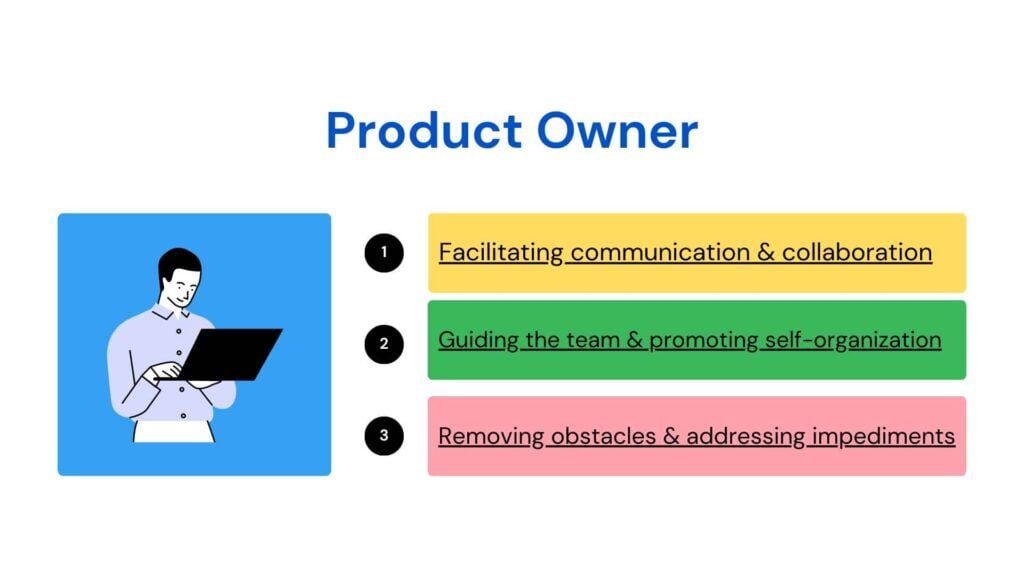
Defining and prioritizing the product backlog
The Product Owner is responsible for defining and maintaining the product backlog, a prioritized list of features, enhancements, and fixes that must be developed. They work closely with stakeholders, customers, and the development team to gather requirements and ensure the product backlog items are well-defined and aligned with the project goals.
The Product Owner uses their understanding of market trends, customer needs, and business objectives to prioritize the items in the product backlog. They consider factors such as value, urgency, dependencies, and technical feasibility when determining the order in which the backlog items will be tackled.
Providing clarity on product requirements and vision
The Product Owner’s responsible for providing clarity on product requirements and communicating the product vision to the development team. They work closely with stakeholders and end-users to understand their needs and translate them into actionable user stories or product backlog items.
The Product Owner ensures that the requirements are clear, concise, and easily understandable by the development team. During backlog refinement sessions, they collaborate with the team to answer questions, provide additional information, and clarify any uncertainties. By delivering precise requirements and a well-defined product vision, the Product Owner sets the direction for the development team.
Collaborating with stakeholders and ensuring their needs are met
The Product Owner acts as the liaison between the development team and stakeholders. They collaborate with stakeholders to gather feedback, understand their expectations, and incorporate their input into the product backlog. The Product Owner represents the stakeholders’ interests and ensures their needs are met throughout development.
They communicate regularly with stakeholders to provide updates, gather feedback, and address any concerns or changes in requirements. By actively involving stakeholders and ensuring their voices are heard, the Product Owner helps build a product that aligns with their expectations and maximizes customer satisfaction.
IV. Key aspects of the Scrum Master-Product Owner relationship
Establishing trust and mutual respect
Trust and mutual respect are essential for any successful relationship, and they are no less critical in the Scrum Master-Product Owner relationship. When the Scrum Master and Product Owner trust each other, they are more likely to be open and honest with each other and more likely to work together to solve problems. Mutual respect is also important, showing that each person values the other’s contributions.
Regular communication and feedback exchange
Regular communication and feedback exchange are essential for maintaining a robust Scrum Master-Product Owner relationship. The Scrum Master and Product Owner need to be able to communicate effectively with each other to share information, discuss ideas, and provide feedback. Feedback is critical, as it can help the Scrum Master and Product Owner to improve their work and to achieve their goals.
Collaborative decision-making and conflict resolution
Collaborative decision-making and conflict resolution are also important aspects of the Scrum Master-Product Owner relationship. The Scrum Master and Product Owner need to be able to work together to make decisions, and they need to be able to resolve conflicts constructively. This requires both people to listen to each other’s perspectives and be ready to compromise.
V. Challenges in the Scrum Master-Product Owner relationship
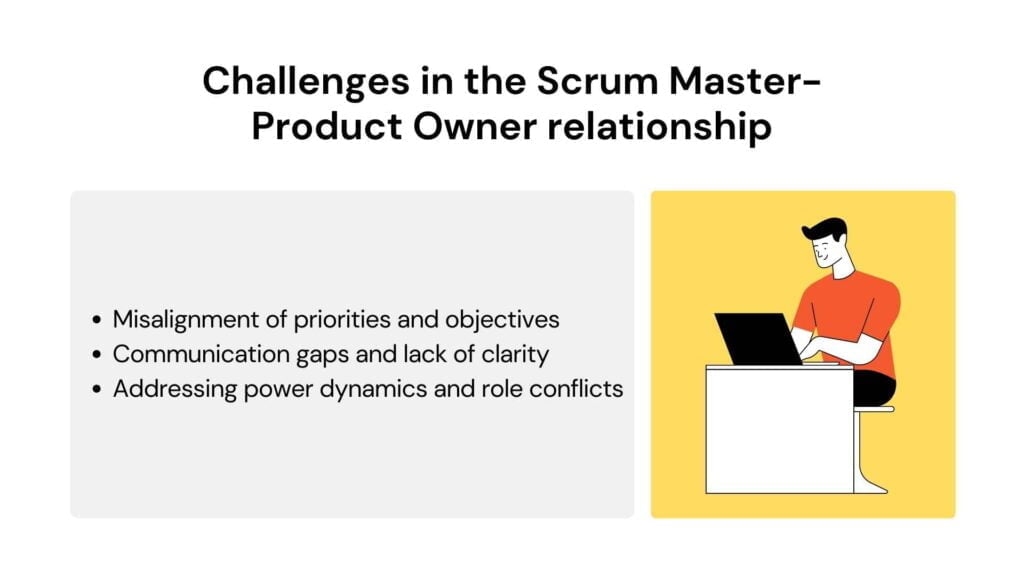
Misalignment of priorities and objectives
One of the biggest challenges in the Scrum Master-Product Owner relationship is the misalignment of priorities and objectives. This can happen when the Scrum Master and Product Owner have different ideas about what is important or are not aligned on the project’s goals. This can lead to conflict, making it difficult to make decisions.
Communication gaps and lack of clarity
Another challenge in the Scrum Master-Product Owner relationship is communication gaps and lack of clarity. This can happen when the Scrum Master and Product Owner do not communicate effectively with each other or when they are not clear about their roles and responsibilities. This can lead to misunderstandings, making it challenging to work together effectively.
Addressing power dynamics and role conflicts
Power dynamics and role conflicts can also challenge the Scrum Master-Product Owner relationship. This can happen when the Scrum Master and Product Owner have different levels of authority or when they have other ideas about how the project should be managed. This can lead to conflict, making it challenging to work together effectively.
VI. Strategies for building a strong Scrum Master-Product Owner relationship
Regularly scheduled meetings and check-ins
One of the best ways to build a robust Scrum Master-Product Owner relationship is to have regularly scheduled meetings and check-ins. This allows the Scrum Master and Product Owner to stay connected, discuss progress, and address any challenges that may arise.
Active listening and empathetic understanding
Active listening and empathetic understanding are essential for building a robust Scrum Master-Product Owner relationship. This means listening to each other’s perspectives without judgment and trying to understand where the other person is coming from.
Promoting transparency and shared ownership is another essential strategy for building a robust Scrum Master-Product Owner relationship. This means being open and honest with each other and transferring ownership of the product and the project.
VII. Benefits of a strong Scrum Master-Product Owner relationship
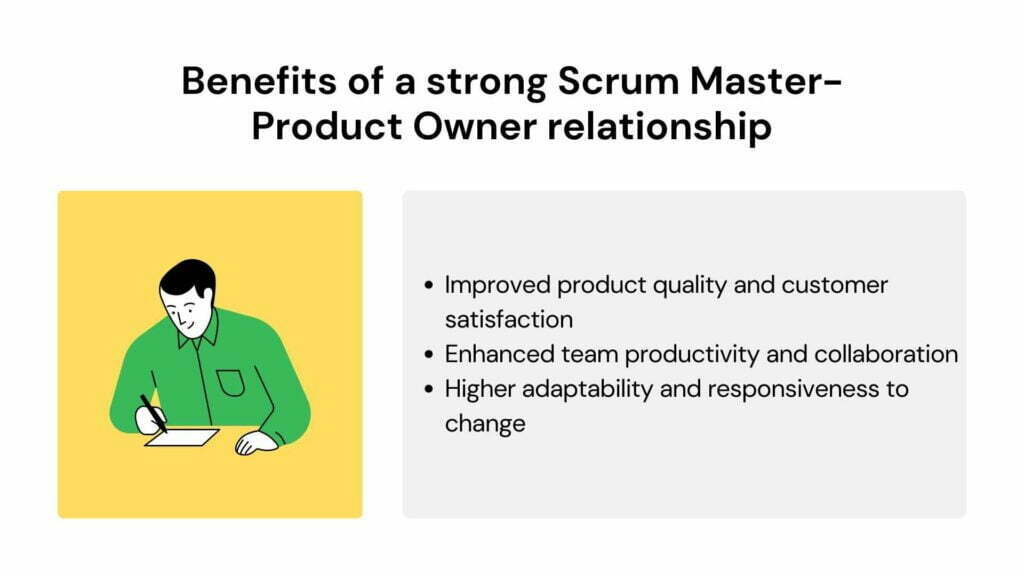
Improved product quality and customer satisfaction
A strong Scrum Master-Product Owner relationship can improve product quality and customer satisfaction. This is because the Scrum Master and Product Owner can work together to ensure that the product meets the customer’s needs. They are also able to identify and address any potential problems with the product early on, which can help to prevent defects and improve the overall quality of the product.
Enhanced team productivity and collaboration
A strong Scrum Master-Product Owner relationship can also enhance team productivity and collaboration. This is because the Scrum Master and Product Owner can work together to create a clear product vision and set realistic goals. They can also create an environment where the team feels supported and empowered, increasing productivity and collaboration.
Higher adaptability and responsiveness to change
A strong Scrum Master-Product Owner relationship can lead to higher adaptability and responsiveness to change. This is because the Scrum Master and Product Owner can work together to adapt to the market quickly or customer needs changes. They can also make decisions rapidly and effectively, which can help the team stay ahead of the competition.
VIII. Conclusion
The Scrum Master and Product Owner are two of the most critical roles in Scrum. They work closely to ensure the team can deliver value to the customer. A strong Scrum Master-Product Owner relationship is essential for the success of any Scrum project.
Scrum Masters and Product Owners should consciously try to foster a strong partnership. This means regularly communicating with each other, being clear about their roles and responsibilities, and being willing to compromise. When the Scrum Master and Product Owner work together effectively, they can achieve great things.
AgileBox is a Jira app that helps teams plan, collaborate, and track their agile projects. This is a powerful tool that can help teams improve their agile development process, which is developed by DevSamurai team. AgileBox makes the Agile process seamless, simple, fun, colorful, and productive.
This toolbox is for Agile teams to estimate, prioritize the product backlog, conduct retrospectives, daily standup & team health analysis, with three main features: Planning Poker for Jira, Agile Retrospective for Jira, and Daily Standup for Jira.
Try out our app now: Agile Planning Poker, Retrospectives, Daily Standup for Jira

